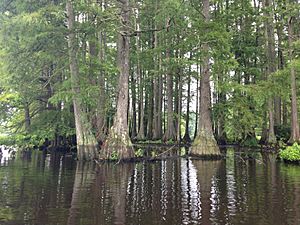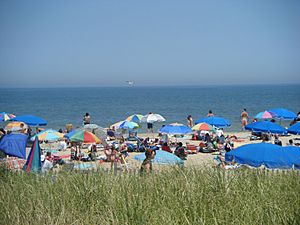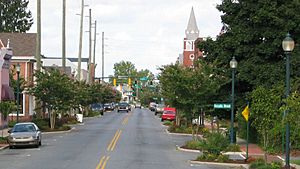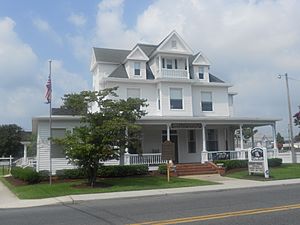Sussex County, Delaware facts for kids
Quick facts for kids
Sussex County
|
|||
|---|---|---|---|
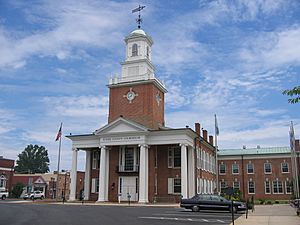
Sussex County Courthouse in Georgetown
|
|||
|
|||

Location within the U.S. state of Delaware
|
|||
 Delaware's location within the U.S. |
|||
| Country | |||
| State | |||
| Founded | August 8, 1683 | ||
| Named for | Sussex, England | ||
| Seat | Georgetown | ||
| Largest city | Seaford | ||
| Area | |||
| • Total | 1,196 sq mi (3,100 km2) | ||
| • Land | 936 sq mi (2,420 km2) | ||
| • Water | 260 sq mi (700 km2) 21.7% | ||
| Population
(2020)
|
|||
| • Total | 237,378 | ||
| • Density | 253.61/sq mi (97.92/km2) | ||
| Time zone | UTC−5 (Eastern) | ||
| • Summer (DST) | UTC−4 (EDT) | ||
| Congressional district | At-large | ||
Sussex County is a county located in the southern part of Delaware. It sits on the Delmarva Peninsula, a large piece of land shared by Delaware, Maryland, and Virginia.
In 2020, about 237,378 people lived here. This makes it the second most populated county in Delaware. The main town where the county government is located is Georgetown.
The first European settlement in Delaware was started by the Dutch in 1631. It was near the town of Lewes, on the Atlantic Coast. However, Sussex County officially began in 1683 under English rule.
Sussex County is part of the Salisbury metropolitan area. This area includes parts of Maryland and Delaware.
Contents
History of Sussex County
Early Inhabitants
Scientists believe that the first people arrived in Sussex County a very long time ago. This was between 10,000 and 14,000 years ago. These early groups lived along the rivers and coast. They often had villages for fishing during different seasons.
The Native American tribes here spoke Algonquian languages. These were common among coastal people along the Atlantic Ocean. The main tribes were the Lenape and the Nanticoke.
They lived near water to find fish, oysters, and other shellfish. In warmer months, women grew crops and prepared food. Men hunted deer and other small animals.
European Explorers Arrive
It's not clear which European group first saw Sussex County. Some historians think Spanish or Portuguese explorers were here first. This was between 1593 and 1630. They likely saw the Delaware River and the land around it.
In 1609, Henry Hudson explored the area for the Dutch. He discovered what is now the Delaware River. A year later, in 1610, an English explorer named Samuel Argall was blown off course. He landed in a bay and named it after the Governor of Virginia, Lord De La Warr.
In 1613, a Dutch sailor named Cornelius Jacobsen May explored the Delaware Bay. He named Cape May and Cape Henlopen. Later, it was found that his "Henlopen" was actually Fenwick Island. The name Cape Henlopen was then moved to its current spot near Lewes.
First European Settlements
Sussex County was home to Delaware's first European settlement. It was a Dutch trading post called Zwaanendael. This was near where Lewes is today. In 1631, Dutch captain David Pietersz. de Vries started a whaling colony there.
But the colony did not last long. In 1632, Native American tribes attacked. They killed the men and burned the settlement. The Dutch tried to settle the area again later.
In 1662, the city of Amsterdam gave land to a group of Mennonites. They started a settlement in 1663. This was partly to stop the English from taking over the area. However, the English took control from the Dutch in 1664. They destroyed the Mennonite settlement that same year.
After the English took over, settlement was slow. The Swedes and Finns who were already there were allowed to stay. But the Dutch were sent away. The land was far from other towns. It was also a place where pirates could hide.
The Dutch briefly took back the land in 1673 during a war. They created two counties, including one in the south. But in 1674, the land went back to the English. It was then controlled by James Stuart, Duke of York.
Sussex County is Named
In 1680, the Duke of York reorganized the southern part of the territory. He called it Deale County. Its main town was New Deale, which is now Lewes.
In 1682, the English King Charles II gave the Delaware lands to William Penn. This was to pay off family debts. Penn then renamed the counties. Deale County became Sussex County. This was named after Penn's home in Sussex County, England. He brought 200 people from Sussex, England, to live here. New Deale was renamed Lewistown, now known as Lewes.
There were long arguments about the border between Pennsylvania and Maryland. In 1732, an agreement was made to draw a line. But the Maryland leader, Lord Baltimore, later said he didn't agree to the terms. This led to some fighting between settlers.
In 1750-1751, a line was surveyed. This line set the southern border of Sussex County. But people in the disputed area still paid taxes to Maryland for many years.
The problem was finally solved in 1760 by the King. He ordered Lord Baltimore to accept the 1732 agreement. Then, two English surveyors, Charles Mason and Jeremiah Dixon, were hired. Between 1763 and 1767, they surveyed the Mason-Dixon line. This line set Sussex County's western borders.
Moving the County Seat
In 1769, people wanted to move the county seat from Lewes. They wanted it to be in a more central spot. In 1791, residents in western Sussex County asked the Delaware General Assembly to move it. Travel was hard back then.
So, Georgetown was chosen as the new county seat. It was not a town before this. In 1791, land was bought, and the town was planned. It was laid out in a circle, one mile across. The center square is now a historic place. Georgetown was named after George Mitchell, who was the head of the State Senate.
Sussex County has had other names. Before 1680, the Dutch called it Hoorenkill or Whorekill County. From 1680 to 1682, it was Deale County. It was also called Durham County for a short time during the border disputes.
Geography and Nature
Sussex County is the largest county in Delaware by land area. It covers about 936 square miles of land. Another 260 square miles is water. This means water makes up about 21.7% of the county.
Like all Delaware counties, Sussex County is divided into areas called Hundreds. There are different ideas about why they are called Hundreds. It might have been an area with 100 families, 100 people, or enough land to raise 100 soldiers. Sussex County has eleven Hundreds.
The eastern part of the county has most of Delaware's beaches. Many popular seaside resorts are found here. The western side of the county is known for its farms. More land is used for farming here than anywhere else in the state.
Sussex County has many saltwater and freshwater wetlands. A famous one is the Great Cypress Swamp. This large freshwater swamp has the northernmost Bald Cypress trees in the United States.
Prime Hook National Wildlife Refuge is a large natural area. It covers 10,000 acres along the western shore of Delaware Bay. This refuge has many different habitats. These include marshes, woodlands, grasslands, and ponds. It is home to 267 types of birds. Many reptiles, amphibians, and mammals also live there.
Neighboring Counties
- Kent County, Delaware – to the north
- Cape May County, New Jersey – to the northeast
- Worcester County, Maryland – to the south
- Dorchester County, Maryland – to the southwest
- Wicomico County, Maryland – to the southwest
- Caroline County, Maryland – to the northwest
Main Roads
 US 9
US 9 US 13
US 13 US 113
US 113 DE 1
DE 1 DE 16
DE 16 DE 20
DE 20 DE 24
DE 24 DE 26
DE 26 DE 54
DE 54
Protected Natural Areas
Population and People
| Historical population | |||
|---|---|---|---|
| Census | Pop. | %± | |
| 1790 | 20,488 | — | |
| 1800 | 19,358 | −5.5% | |
| 1810 | 27,750 | 43.4% | |
| 1820 | 24,057 | −13.3% | |
| 1830 | 27,115 | 12.7% | |
| 1840 | 25,093 | −7.5% | |
| 1850 | 25,936 | 3.4% | |
| 1860 | 29,615 | 14.2% | |
| 1870 | 31,696 | 7.0% | |
| 1880 | 36,018 | 13.6% | |
| 1890 | 38,647 | 7.3% | |
| 1900 | 42,276 | 9.4% | |
| 1910 | 46,413 | 9.8% | |
| 1920 | 43,741 | −5.8% | |
| 1930 | 45,507 | 4.0% | |
| 1940 | 52,502 | 15.4% | |
| 1950 | 61,336 | 16.8% | |
| 1960 | 73,195 | 19.3% | |
| 1970 | 80,356 | 9.8% | |
| 1980 | 98,004 | 22.0% | |
| 1990 | 113,229 | 15.5% | |
| 2000 | 156,638 | 38.3% | |
| 2010 | 197,145 | 25.9% | |
| 2020 | 237,378 | 20.4% | |
| 2023 (est.) | 263,509 | 33.7% | |
| U.S. Decennial Census 1790-1960 1900-1990 1990-2000 2010-2020 |
|||
In 2010, there were 197,145 people living in Sussex County. The population density was about 210 people per square mile. Most people were white (79.0%), with 12.7% being Black or African American. About 8.6% of the population was of Hispanic or Latino origin.
The average age of people in the county was 45.4 years old. The median income for a family was about $59,053. About 11.7% of the population lived below the poverty line.
By 2020, the population grew to 237,378. In 2021, the population was 75.4% non-Hispanic white. It was 11.8% Black or African American. About 9.6% of the population was Hispanic or Latino.
Economy and Jobs

The economy of Sussex County mostly depends on farming. Sussex County produces more poultry (like chickens and turkeys) than any other county in the United States.
Tourism is also a big part of the economy. This is especially true in eastern Sussex County, where the beaches are. The Delaware Beaches bring in billions of dollars each year. They also create a lot of tax money.
Home prices in Sussex County have gone up a lot. Between 1995 and 2005, the average home price increased by 250%. For example, in Millsboro, prices went up 381%. In Millville, they went up 609%.
The county is served by two main railroads. These are the Delmarva Central Railroad and the Maryland and Delaware Railroad.
Education in Sussex County
Public Schools
Sussex County has eight public school districts. These districts serve students across the county.
- Cape Henlopen School District
- Delmar School District
- Indian River School District
- Laurel School District
- Milford School District (also in Kent County)
- Seaford School District
- Woodbridge School District (also in Kent County)
- Sussex Technical School District (county-wide)
There is also one charter school called the Sussex Academy of Arts & Sciences. High schools that play sports are part of the Henlopen Conference.
Private Schools
Sussex County has several private schools. Some examples include:
- Bible Center Christian Academy (Laurel)
- Delmarva Christian High School (Georgetown)
- Epworth Christian School (Laurel)
- Greenwood Mennonite School (Greenwood)
- Milford Christian School (Milford)
Colleges and Universities
There are several colleges and universities in Sussex County. Delaware Technical Community College has a large campus here. Students can also attend:
- Delaware State University (Georgetown campus)
- Goldey-Beacom College (Georgetown campus)
- University of Delaware (Georgetown campus)
- Beebe Hospital School of Nursing (Lewes)
The University of Delaware also has a marine science campus in Lewes.
Culture and Traditions
The culture in Sussex County is similar to other parts of the Delmarva. It feels a lot like the Southern United States.
Farming and commercial fishing are very important here. Most of the land is rural, with only a few larger towns. Many local restaurants serve southern cuisine. You might find sweet tea and dishes with greens. Fried food is also very popular.
Many people in rural Sussex County speak with a variation of Southern American English. This is common in other Delmarva counties too.
Festivals and Events
Sussex County hosts many fun festivals and events.
- The Bethany Beach Jazz Funeral marks the end of summer.
- The Apple Scrapple Festival is in Bridgeville.
- The Return Day Parade happens in Georgetown after elections.
- The Laurel Independence Day Celebration is a big event.
- The Nanticoke Indian Pow Wow is held in Oak Orchard.
- Rehoboth Beach has a Chocolate Festival and an Independent Film Festival.
- The Rehoboth Beach Jazz Festival is also popular.
- The Sea Witch Halloween Festival and Parade is in Rehoboth Beach.
- The Seaford Riverfest is a local favorite.
Sussex County is also home to the Senior League Softball World Series in Roxana. The World Championship Punkin Chunkin event used to be held here.
Media
Newspapers
- Cape Gazette
- Coastal Point, Ocean View
- Delaware Coast Press, Rehoboth Beach
- Delaware Wave, Bethany Beach
- Hoy en Delaware, Georgetown
- Laurel Star, Laurel
- Leader & State Register, Seaford
- Seaford Star, Seaford
- Sussex Countian
- Sussex Post, Georgetown
- The Script, Georgetown (student newspaper)
Radio Stations
| Call sign | Frequency | City of license | Owner | Format |
|---|---|---|---|---|
| WUSX | 98.5 FM | Seaford | Adams Radio Group | Country |
| WGMD | 92.7 FM | Rehoboth Beach | Resort Broadcasting Co., LLC | News Talk Information |
| WJKI-FM | 103.5 FM | Bethany Beach | The Voice Radio, LLC | Classic Rock |
| WJWL | 900 AM | Georgetown | Great Scott Broadcasting | Spanish Variety |
| WKDB | 95.3 FM | Laurel | Great Scott Broadcasting | Contemporary Hit Radio |
| WOCM | 98.1 FM | Selbyville | Irie Radio, Inc. | Album Adult Alternative |
| WRBG-LP | 106.5 FM | Millsboro | Rhythm and Blues Group Harmonty Association, Inc. | |
| WSUX | 1280 AM | Seaford | Great Scott Broadcasting | Spanish Variety |
| WZBH | 93.5 FM | Georgetown | Adams Radio Group | Active Rock |
| WZEB | 101.7 FM | Ocean View | Great Scott Broadcasting | Contemporary Hit Radio |
| WXDE | 105.9 FM | Lewes | Delmarva Broadcasting Company | News Talk |
Television Channels
Sussex County is part of the Salisbury television market. However, channels from Philadelphia and Baltimore are often available.
- WBOC, Salisbury, CBS & Fox
- WDPB, Seaford, PBS
- WMDT, Salisbury, ABC & The CW
- WRDE-LD, Salisbury, NBC and MyTV
- WBAL, Baltimore, NBC
- WJZ, Baltimore, CBS
- WCAU, Philadelphia, NBC
- WTXF, Philadelphia, Fox
Communities in Sussex County
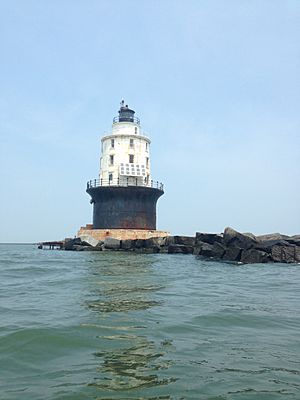
Cities
- Lewes
- Milford (partly in Kent County)
- Rehoboth Beach
- Seaford
Towns
Unincorporated Communities
- Gumboro
- Lincoln
- Long Neck (a place with a defined population)
- Oak Orchard
- Reliance (partly in Maryland)
- Roxana
See also
 In Spanish: Condado de Sussex (Delaware) para niños
In Spanish: Condado de Sussex (Delaware) para niños




